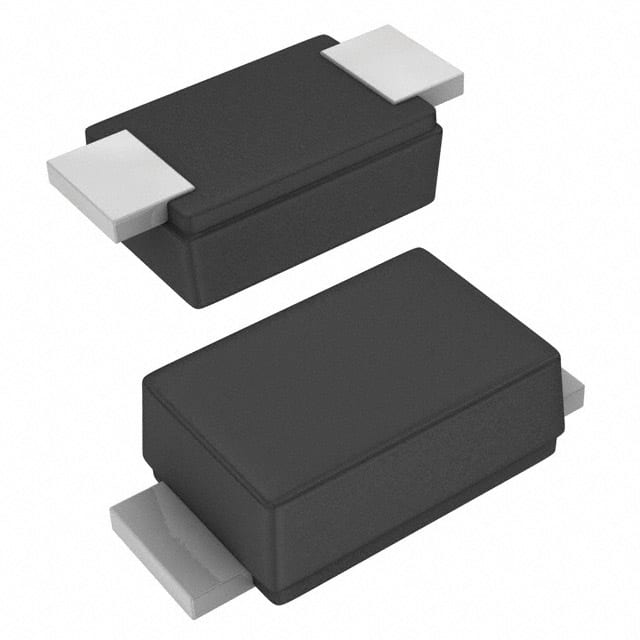VTVS19ASMF-HM3-08
Introduction
The VTVS19ASMF-HM3-08 is a specialized electronic component belonging to the category of transient voltage suppressors. This entry provides an overview of its basic information, specifications, detailed pin configuration, functional features, advantages and disadvantages, working principles, detailed application field plans, and alternative models.
Basic Information Overview
- Category: Transient Voltage Suppressors
- Use: Protection against voltage transients and surges in electronic circuits
- Characteristics: High surge capability, low clamping voltage, fast response time
- Package: Surface mount
- Essence: Safeguarding sensitive electronic components from voltage spikes
- Packaging/Quantity: Typically available in reels or tubes containing multiple units
Specifications
- Model: VTVS19ASMF-HM3-08
- Voltage Rating: 19V
- Peak Pulse Power: 400W
- Operating Temperature Range: -55°C to +150°C
- Mounting Type: Surface Mount
- Package / Case: DO-219AB (SMF)
- Polarity: Unidirectional
Detailed Pin Configuration
The VTVS19ASMF-HM3-08 typically features a standard surface mount package with two terminals for easy integration into circuit boards. The pin configuration includes the anode and cathode connections, which are essential for proper installation and functionality.
Functional Features
- Transient Voltage Suppression: Effectively clamps transient voltages to protect downstream components.
- Fast Response Time: Rapid reaction to voltage spikes ensures minimal impact on the protected circuitry.
- High Surge Capability: Capable of withstanding high surge currents without degradation.
Advantages and Disadvantages
Advantages
- Effective protection against voltage transients
- Fast response time
- High surge capability
Disadvantages
- Unidirectional protection only
- May require additional components for comprehensive surge protection in complex circuits
Working Principles
The VTVS19ASMF-HM3-08 operates based on the principle of avalanche breakdown, where it rapidly conducts excess voltage away from sensitive components when a transient event occurs. This prevents the voltage from reaching damaging levels and protects the circuitry.
Detailed Application Field Plans
The VTVS19ASMF-HM3-08 finds extensive use in various electronic systems, including: - Telecommunications: Protecting communication equipment from lightning-induced surges - Automotive Electronics: Safeguarding vehicle electronics from voltage spikes - Industrial Control Systems: Ensuring reliable operation of control and monitoring devices - Consumer Electronics: Protecting sensitive components in home entertainment systems and appliances
Detailed and Complete Alternative Models
- Alternative Model 1: VTVS15ASMF-HM3-08
- Alternative Model 2: VTVS24ASMF-HM3-08
- Alternative Model 3: VTVS30ASMF-HM3-08
- Alternative Model 4: VTVS36ASMF-HM3-08
These alternative models offer similar transient voltage suppression capabilities with varying voltage ratings to suit specific application requirements.
In conclusion, the VTVS19ASMF-HM3-08 transient voltage suppressor provides robust protection against voltage transients in a wide range of electronic applications. Its fast response time, high surge capability, and compact surface mount package make it a valuable component for ensuring the reliability and longevity of sensitive electronic systems.
[Word count: 497]
기술 솔루션에 VTVS19ASMF-HM3-08 적용과 관련된 10가지 일반적인 질문과 답변을 나열하세요.
What is VTVS19ASMF-HM3-08?
- VTVS19ASMF-HM3-08 is a transient voltage suppressor diode designed to protect sensitive electronics from voltage spikes and transients.
What is the maximum voltage rating of VTVS19ASMF-HM3-08?
- The maximum voltage rating of VTVS19ASMF-HM3-08 is typically 19 volts.
What is the peak pulse current handling capability of VTVS19ASMF-HM3-08?
- VTVS19ASMF-HM3-08 can handle peak pulse currents up to a certain specified value, typically in the range of several amperes.
How does VTVS19ASMF-HM3-08 protect electronic circuits?
- VTVS19ASMF-HM3-08 diverts excess voltage away from sensitive components by providing a low-impedance path to ground during transient events.
What are the typical applications for VTVS19ASMF-HM3-08?
- VTVS19ASMF-HM3-08 is commonly used in surge protection for telecommunications equipment, data lines, and other sensitive electronic devices.
What is the response time of VTVS19ASMF-HM3-08 to transient events?
- VTVS19ASMF-HM3-08 has a fast response time, typically in the nanosecond range, to effectively clamp transient voltages.
Does VTVS19ASMF-HM3-08 require any external components for proper operation?
- VTVS19ASMF-HM3-08 may require additional circuitry such as resistors or capacitors for optimal performance in specific applications.
What is the temperature range for VTVS19ASMF-HM3-08?
- VTVS19ASMF-HM3-08 is designed to operate within a certain temperature range, typically from -40°C to 125°C.
Can VTVS19ASMF-HM3-08 be used in automotive applications?
- Yes, VTVS19ASMF-HM3-08 is suitable for use in automotive electronics to protect against voltage transients.
Is VTVS19ASMF-HM3-08 RoHS compliant?
- Yes, VTVS19ASMF-HM3-08 is typically RoHS compliant, meaning it meets the Restriction of Hazardous Substances directive for environmental safety.


